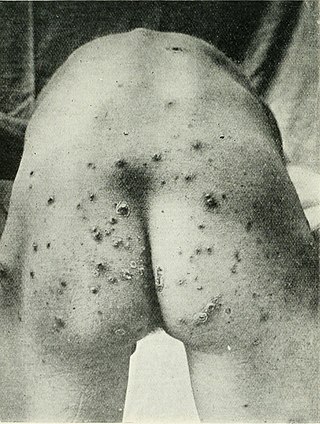Related Research Articles

Chronic granulomatous disease (CGD), also known as Bridges–Good syndrome, chronic granulomatous disorder, and Quie syndrome, is a diverse group of hereditary diseases in which certain cells of the immune system have difficulty forming the reactive oxygen compounds used to kill certain ingested pathogens. This leads to the formation of granulomas in many organs. CGD affects about 1 in 200,000 people in the United States, with about 20 new cases diagnosed each year.

Rhinoscleroma, is a chronic granulomatous bacterial disease of the nose that can sometimes infect the upper respiratory tract. It most commonly affects the nasal cavity—the nose is involved in 95–100 per cent of cases—however, it can also affect the nasopharynx, larynx, trachea, and bronchi. Slightly more females than males are affected and patients are usually 10 to 30 years of age. Rhinoscleroma is considered a tropical disease and is mostly endemic to North Africa, South Asia and Central America, less common in the United States.

Pyoderma gangrenosum is a rare, inflammatory skin disease where painful pustules or nodules become ulcers that progressively grow. Pyoderma gangrenosum is not infectious.

Necrobiosis lipoidica is a rare, chronic skin condition predominantly associated with diabetes mellitus. It can also occur in individuals with rheumatoid arthritis or without any underlying conditions (idiopathic). It is characterized by hardened, raised areas of the skin, often appearing on the shins, with a yellowish center and a surrounding dark pink area. The lesions are generally asymptomatic but can become tender and ulcerate when injured.

The Koebner phenomenon or Köbner phenomenon, also called the Koebner response or the isomorphic response, attributed to Heinrich Köbner, is the appearance of skin lesions on lines of trauma. The Koebner phenomenon may result from either a linear exposure or irritation. Conditions demonstrating linear lesions after a linear exposure to a causative agent include: molluscum contagiosum, warts and toxicodendron dermatitis. Warts and molluscum contagiosum lesions can be spread in linear patterns by self-scratching ("auto-inoculation"). Toxicodendron dermatitis lesions are often linear from brushing up against the plant. Causes of the Koebner phenomenon that are secondary to scratching rather than an infective or chemical cause include vitiligo, psoriasis, lichen planus, lichen nitidus, pityriasis rubra pilaris, and keratosis follicularis.

Cheilitis is a medical condition characterized by inflammation of the lips. The inflammation may include the perioral skin, the vermilion border, or the labial mucosa. The skin and the vermilion border are more commonly involved, as the mucosa is less affected by inflammatory and allergic reactions.

Pyoderma means any skin disease that is pyogenic. These include superficial bacterial infections such as impetigo, impetigo contagiosa, ecthyma, folliculitis, Bockhart's impetigo, furuncle, carbuncle, tropical ulcer, etc. Autoimmune conditions include pyoderma gangrenosum. Pyoderma affects more than 111 million children worldwide, making it one of the three most common skin disorders in children along with scabies and tinea.

Hidrocystoma is an adenoma of the sweat glands.
Pathergy is a skin condition in which a minor trauma such as a bump or bruise leads to the development of skin lesions or ulcers that may be resistant to healing. Pathergy can also lead to ulcerations at the site of surgical incisions. Pathergy is seen with both Behçet's disease and pyoderma gangrenosum. A highly similar phenomenon known as the Koebner phenomenon occurs in autoimmune diseases such as psoriasis and systemic lupus erythematosus, among others.

Lupus miliaris disseminatus faciei, also known as acne agminata, is a disease with a similar appearance to acne vulgaris. The cause of LMDF is unknown.

Blau syndrome is an autosomal dominant genetic inflammatory disorder which affects the skin, eyes, and joints. It is caused by a mutation in the NOD2 (CARD15) gene. Symptoms usually begin before the age of four, and the disease manifests as early onset cutaneous sarcoidosis, granulomatous arthritis, and uveitis.
Palisaded neutrophilic and granulomatous dermaititis (PNGS) is usually associated with a well-defined connective tissue disease, lupus erythematosus or rheumatoid arthritis most commonly, and often presents with eroded or ulcerated symmetrically distributed umbilicated papules or nodules on the elbows.

PAPA syndrome is a rare genetic disorder characterised by its effects on skin and joints. The acronym PAPA stands for pyogenic arthritis, pyoderma gangrenosum and acne.
Silicone granulomas are a skin condition that occur as a reaction to liquid silicones, and are characterized by the formation of nodules.
Blastomycosis-like pyoderma is a cutaneous condition characterized by large verrucous plaques with elevated borders and multiple pustules.
Granuloma gluteale infantum is a cutaneous condition that appears in the anogenital region of infants as a complication of diaper dermatitis. According to some, no granulomas are found.
Rheumatoid neutrophilic dermatitis, also known as rheumatoid neutrophilic dermatosis, is a cutaneous condition associated with rheumatoid arthritis.
Pseudomonal pyoderma is a cutaneous condition, a superficial infection of the skin with P. aeruginosa. The skin can have a 'mousy' odor. It presents typically on the feet with macerated 'moth-eaten' appearance, green-blue purulence, and eroded borders.
Pseudomonas hot-foot syndrome is a self-limited cutaneous condition that occurs on the plantar surface of children after swimming in pool water that has high concentrations of P. aeruginosa. The condition typically presents as plantar purple-red nodules.
References
- ↑ Rapini, Ronald P.; Bolognia, Jean L.; Jorizzo, Joseph L. (2007). Dermatology: 2-Volume Set. St. Louis: Mosby. ISBN 1-4160-2999-0.
- ↑ Grech, Sarah Borg; Baldacchino, Andrea Vella; Corso, Roberto; Pisani, David; Boffa, Michael J (2021). "Superficial Granulomatous Pyoderma Successfully Treated with Intravenous Immunoglobulin". European Journal of Case Reports in Internal Medicine. European Federation of Internal Medicine. 8 (9). doi:10.12890/2021_002656. PMID 34671571 . Retrieved February 6, 2024.